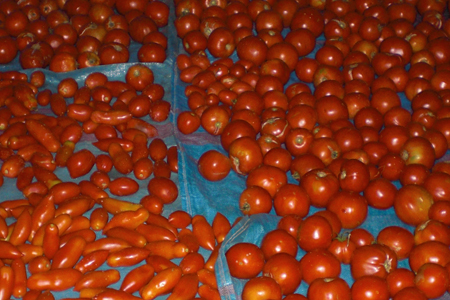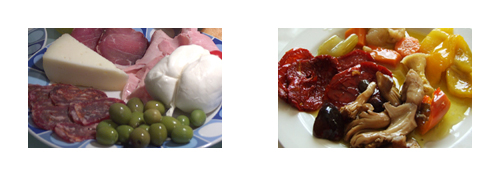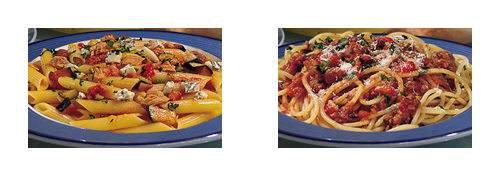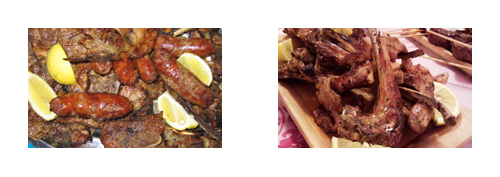Cuisine
PRODUCE - obviously with Abruzzo being part of Italy there is a great need for pasta and Fara San Martino is home to 2 of the worldwide renowned pasta producers - De Cecco and Delverde. To many people pasta means spaghetti but pasta comes in all shapes and forms - penne rigate, penne lisce, rigatoni, tortiglioni, perciatelli, papardelle, farfalle, lumache - the list is endless. Each shape will usually have its own special recipes or accompaniments.

Pomodoro - tomatoes are widely grown in Abruzzo whether it be the huge beefeaters or the smaller plum. The former is used in the summer salad or panini and the latter used to "fare le bottiglie", a term meaning to bottle and preserve the tomatoes to make sauces, the most common sauce cooked with pasta.

Olio d'Oliva - a symbol of the Mediterranean culture olive oil is also widely produced in Abruzzo with little factories dispersed all over the province. These ‘frantoi’ are put to work 24 hours a day come November and December when the locals bring their harvest, some of which is kept for personal use and some of which is sold on to the larger distributors.
Wine - I'm sure everyone is aware that the typical drink used in Italy to wash down the pasta is wine. In Abruzzo the famous wines are the red Montepulciano, Cerasuolo the rosé and Trebbiano the white. These grapes are grown extensively in the hills of the province of Chieti, the second largest wine producing province in Italy, Abruzzo being the 5th largest wine producing region.
Salumi - another of Abruzzo's specialities are the cured meats (salumi), usually pork. Famous from the town of Vasto is the 'ventricina', a rather unique hot and spicy flavour manufactured from particular pieces of pork, minced and mixed with salt, pepper, fennel seeds and various strengths of chilli powder. Produced in various towns such as Lanciano and Mozzagrogna is another form of salami known as 'salsicciotto', using less fat than typical salamis with the only additives being salt and pepper.
Cheese - there are many forms and flavours of cheese in Abruzzo, 'caciocavallo' being one example. Cavallo may mean horse but this cheese like most others is made from curdled cow's milk, the alternative being goat's milk.The term 'a cavallo' refers to the mode of maturing ie. suspended between 2 poles. This cheese is easily recognisable by its pear-shaped form. 'Scamorza' is another local delicacy - a fresh, soft form of mozzarella, delicious in a summer salad accompanying sliced tomatoes.
DISHES - dining out, weddings and other special occasions usually involves a 4 course meal, each course having various dishes. For some, who might not be used to dining Italian style, it would be recommended to share an antipasto between 2 or 3 persons and then have a 'primo' the first time eating out, then next time perhaps a 'primo' and 'secondo' just to see how filling these dishes can be.

Antipasto - the starter or 'antipasto' can include a few slices of prosciutto, salami of different flavours and strengths, cheese, which may be served fresh or grilled, and bread. The plate may also have servings of olives and other vegetables such as artichokes, asparagus or mushrooms 'sotto olio' (in olive oil). 'Bruschetta' is a regular feature of the antipasto - a slice of toasted bread (pane) with olive oil, tomatoes and/or other ingredient as toppings.

Primo - the first course can include one or more pasta dishes or a risotto (rice), depending on the occasion. Taditional in Abruzzo is 'ravioli', small pockets of pasta stuffed with spinach and ricotta cheese, which may sound strange to some but served in a rich tomato sauce has to be sampled. Most sauces will include crushed tomatoes and have a meat flavoured base with additives such as garlic, onion, rosemary, basil or chilli adjusting the flavours, any of which may be served with another typical dish, 'pasta alla chitarra', so called because it is made on an article resembling a guitar. Pasta 'fagioli' is a bean dish which may be served with any of a number of different short pasta shapes. Between the various forms of pasta and the rich variety of vegetables, pulse and meats there is no shortage of 'primi' on the menu.

Secondo - the second course (or courses) usually includes at least 1 meat dish and 'contorno', vegetables, salad or potatoes. Researching the various dishes eaten locally it was not possible to give acclaim for any to Abruzzo but the menu is both large and varied. Rabbit, lamb or chicken is delicious 'al forno' (roasted in the oven), cooked with potatoes and various herbs. Braising white meats in wine on the hob is an alternative.
The winter months with fires lit to keep out the cold means cooking 'alla brace' (over the embers), a taste which cannot be matched even by the best barbecue - obviously restaurants can cook this way all year round. Local sausages, 'salsicce', lamb chops, fillet steak or even fresh cheese all taste much better 'alla brace'.
Veal, 'vitello', is a meat which is preferred in Italy to the tougher adult bovine and is delicious cooked simply in olive oil or coated in breadcrumbs or flour. It is not now necessary to visit Florence to sample the famous ‘Fiorentina’ as it is served in some of the local restaurants.
The final course in an Italian meal is either fruit, coffee and digestive (not the biscuit) such as 'grappa' or whiskey, or cake and coffee, or simply coffee depending on the occasion.
EATING OUT - Everyone enjoys dining out and being catered for occasionally, and even with the great wealth of foods in the typical Italian household the Abruzzesi are no different. From expensive cordon bleu restaurants to family run ‘agriturismi’ there are no shortage of eating establishments.
Ristoranti - most restaurants in Abruzzo will offer similar menus serving traditional recipes as already mentioned under the ‘dishes’ section, although most will have their own speciality. Similar to whether you prefer to sleep 3, 4, or 5 star, food establishment prices will range depending on the location, the ambience and the service offered. Some restaurants do not have menus as such - the ‘cameriere’, waiter(tress), will arrive at the table and tell you what is on offer - which can be a handicap if you are not familiar with the language but can also be a very interesting experience. Don't be concerned about doing what everyone else does - if you only want a pasta dish (primo) and a meat dish (secondo) then tell them "non antipasto". With regards to drinking, the house wine is usually more than palatable.
The restaurants in the locality of Archi are more than adequately equipped to cater for all palates without having to travel further afield, in fact one of them has won an award for their speciality 'Pasta Erotica' which uses asparagus to flavour the freshly made pasta ‘alla chitarra’ and is further enhanced with local ‘tartufo’ (truffe). Other dishes on the menu are tortellone filled with porcini mushrooms, gnocchi di patate and papardelle with hare sauce - all delicious. Another with more of a Tuscan theme serves a risotto cooked at your table using a great crust of ‘parmigiano’ (parmesan), probably the most widely used cheese in Italy.
Pizzeria – Naples is famous for Pizza but again it is not necessary to travel for a delicious Pizza, in fact the proprietor of one of the local haunts in Archi hails from ‘Napoli’. Some Pizzerias use electric ovens to produce a more raised bread type pizza while others use the traditional wood oven to provide a thinner base. Having become accustomed to the tastes of foreigners the menus offer many varied toppings, even ‘ananas’ (pineapple), but it’s best to try something new, each person at the table having a different pizza, sharing their experience. As wine is the preferred beverage to wash down the pasta, beer is popular drink to accompany pizza, although each to his own.
Agriturismi – similar to restaurants with perhaps less decor, these are family run farmhouses which provide meals based on their own produce. Homemade cheese, salumi and breads provide the antipasto, while the ‘primo’ will arrive as freshly made pasta sauces cooked with ingredients from the ‘orto’ (allotment). The attraction to these enterprises was the reduced prices although some have become as busy as restaurants and the costs have increased accordingly.
Bar – apart from the usual ‘panani’ or ‘piadini’, which also should be sampled by the visitor, some of the local Bars serve meals which would grace the table at any restaurant. One advantage is the opportunity to pre-book the menu of your choice.
FISH - Abruzzo's coast is bordered by the Adriatic Sea which offers fresh fish all year round. As with meats and vegetable accompaniments, the prawns, mussels, clams etc. supplement the variety of pasta shapes to create a wide range of 'primi', and the 'secondo' can be fried, baked, steamed or grilled.

The coastline, especially the ports and fishing towns, is full of Fish Restaurants dedicated to the produce from 'il mare', the sea. As with any eating establishment there are various price ranges depending on the service and setting, and different specialities from town to town. Some of the fishing villages have markets or 'Pescherie', fish shops where fresh fis


